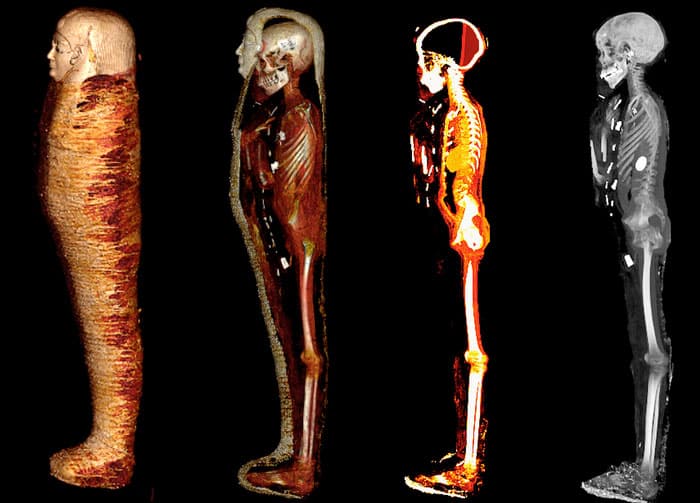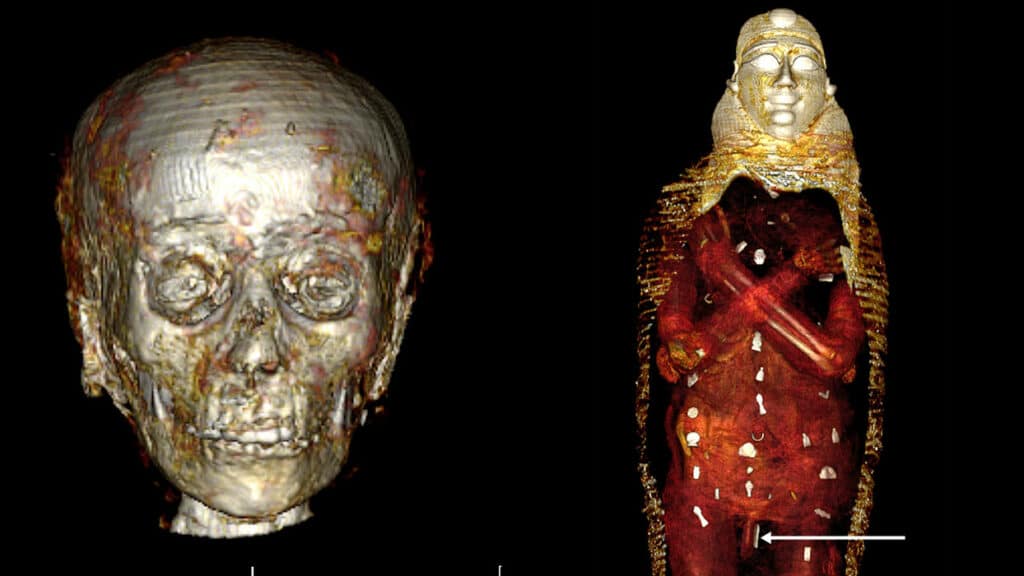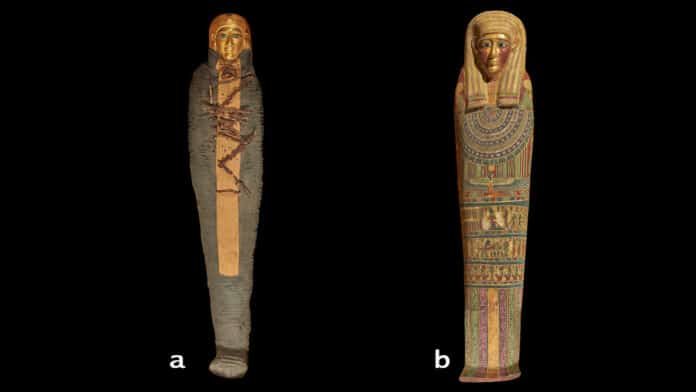Ancient Egyptian mummies represent an opportunity to learn more about humans’ health, beliefs, and skills in antiquity. In the past, mummies were unwrapped and subjected to invasive dissection for research and entertainment.
Finding an ideal compromise between investigating a mummy and not destroying it encouraged the use of less invasive methods. However, the overlapping of the object’s three-dimensional (3D) data on the two-dimensional (2D) x-ray film leads to a loss of data and less satisfactory results. Computed Tomography (CT) represents a significant advance in radiology.
Recently, scientists from Egypt used CT scans to ‘digitally unwrap’ the approximately 2,300-year-old undisturbed mummy of a high socioeconomic status teenage boy. They found that this ‘Golden boy’ is an undisturbed showcase of ancient Egyptian beliefs about life after death.

The body was equipped with 49 amulets of 21 varieties, several of which were made of gold and meticulously placed on or inside it. A golden heart scarab was inserted into the thoracic cavity, a golden tongue was inserted into the mouth, and a pair of amulets with two fingers were placed next to the uncircumcised penis.
An Isis Knot enlisted the power of Isis in the protection of the body, a right-angle amulet was meant to bring balance and leveling, and a double falcon and ostrich plumes represented the duality of spiritual and material life. A golden scarab beetle was found placed inside the thoracic cavity, of which a copy was 3D printed by the scientists.
The mummy was covered with ferns and clad in sandals, both of which had symbolic meaning. This mummy serves as a showcase for Ptolemaic-era Egyptian beliefs about death and the afterlife.
These results provide a unique insight into mummification procedures and beliefs about the importance of grave ornaments during the Ptolemaic period.

Dr. Sahar Saleem, the study’s first author and a professor at the Faculty of Medicine of Cairo University, Egypt, said, “Here we show that this mummy’s body was extensively decorated with 49 amulets, beautifully stylized in a unique arrangement of three columns between the folds of the wrappings and inside the mummy’s body cavity. These include the Eye of Horus, the scarab, the akhet amulet of the horizon, the placenta, the Knot of Isis, and others. Many were made of gold, while some were made of semiprecious stones, fired clay, or faience. Their purpose was to protect the body and give it vitality in the afterlife.”
The boy’s CT scans revealed that he was 128 cm tall, had never been circumcised, and had died of natural causes only. The boy was between 14 and 15, according to the authors’ estimation based on the degree of bone fusion and the non-erupted wisdom teeth. He had healthy teeth with no signs of periodontal disease, tooth loss, or cavities.
The “Golden Boy” mummy was discovered in 1916 at a cemetery in Nag el-Hassay, southern Egypt. The cemetery was in use between around 332 and 30 BCE. Until this research, it had been kept in the Egyptian Museum’s basement without being studied.

The mummy was placed within two coffins: an inner wooden sarcophagus and an outer coffin with a Greek inscription. On the inside, he was dressed in a pair of sandals, a pectoral cartonnage that covered the front of his torso, and a head mask with gold trim. Apart from the heart, the viscera had been removed through an incision, while the brain had been removed through the nose and replaced with resin.
Dr. Saleem said, “The sandals were probably meant to enable the boy to walk out of the coffin. According to the ancient Egyptians’ ritual Book of The Dead, the deceased had to wear white sandals to be pious and clean before reciting its verses.”
“Ferns were garlanded around the mummy’s outer surface. Ancient Egyptians were fascinated by plants and flowers and believed they possessed sacred and symbolic effects. Bouquets of plants and flowers were placed beside the deceased at the time of burial: this was done, for example, with the mummies of the New Kingdom kings Ahmose, Amenhotep I, and Ramesses the Great. The deceased was also offered plants in each visit to the dead during feasts.”
“The heart scarab is mentioned in chapter 30 of the Book of the Dead: it was important in the afterlife during judging the deceased and weighing of the heart against the feather of the goddess Maat. The heart scarab silenced the heart on Judgement Day so as not to bear witness against the deceased. It was placed inside the torso cavity during mummification to substitute for the heart if the body was deprived of this organ.”
The management of the Egyptian Museum decided to move the mummy to the main exhibition hall under the name “Golden Boy” in light of these fascinating findings. To come as close to the glories of ancient Egyptian civilization as possible, visitors can view the mummy in its new location next to CT scans and a 3D printed version of the heart scarab amulet.
Journal Reference:
- Sahar Saleem, Subah Abd el-Razek Seddik and Mahmoud el-Halwagy. Scanning and three-dimensional printing using computed tomography of the “Golden Boy” mummy. Front. Med., 24 January 2023. DOI: 10.3389/fmed.2022.1028377
